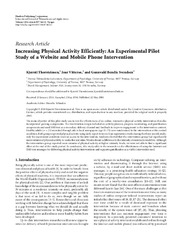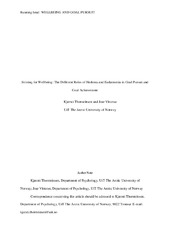| dc.contributor.advisor | Vittersø, Joar | |
| dc.contributor.author | Thorsteinsen, Kjærsti | |
| dc.date.accessioned | 2018-11-19T08:23:40Z | |
| dc.date.available | 2018-11-19T08:23:40Z | |
| dc.date.issued | 2018-11-29 | |
| dc.description.abstract | Being active is a primary necessity in life, but it is also an essential part of what makes life worth living. This thesis explored goal pursuit activities people might not experience as pleasant in the moment, but where the self-chosen activities are still considered good and worthwhile. We hypothesized that online self-regulation interventions would be effective in increasing effortful physical and mental activities and that a distinction between hedonic and eudaimonic conceptions of wellbeing would be evident in different stages of goal pursuit. Three papers, building on data from two studies, are presented. In Paper I, the effect of an online intervention for increasing physical activity, named Lifestyle Tool, was tested in a longitudinal study spanning three months. In Paper II, using global measures from a second study, we investigated the reciprocal effects of different wellbeing dimensions and goal pursuit stages before and after an intervention week. In Paper III, we used the experience sampling measures from the second study, and tested the assumption that HWB and EWB reflect two different dimensions of wellbeing and examined differences in emotions from goal pursuit interventions indicating discriminant validity. The results showed that online interventions helped participants self-regulate physical and mental activities. Furthermore, a duality between hedonic wellbeing (HWB) and eudaimonic wellbeing (EWB) were evident in the goal pursuit process: while EWB ignited and sustained wellbeing in effortful goal pursuits, HWB was more related to the outcome phase, rewarding goal achievement. Congruent findings from different analyses also supported convergent and discriminant validity of HWB and EWB as separate constructs. Interventions that help people self-regulate benefit actions viewed as good and conducive to physical and mental health, even though they are not always experienced as pleasant. | en_US |
| dc.description.doctoraltype | ph.d. | en_US |
| dc.description.popularabstract | Det føles fantastisk godt å nå et mål man har jobbet lenge mot, men veien dit er ofte alt annet enn behagelig. Mange ganger er det kanskje både slitsomt og krevende å gjøre de nødvendige aktivitetene for å nå målet. Distraksjonene er mange, men som vi alle har lært: den som venter på noe godt, venter ikke forgjeves. Men er det kun måloppnåelsen til slutt som gir belønning i form av den gode følelsen? Eller kan det å jobbe mot et mål i seg selv føles godt til tross for at det til tider både er slitsomt og krevende? I denne doktoravhandlinga rapporteres to studier der mobiltelefonen blir brukt både som verktøy for å fremme måljobbing hos deltakerne, og for å få innblikk i hvordan det å jobbe med mål oppleves underveis. Resultatene knyttes opp mot to ulike typer livskvalitet: hedonisk og eudaimonisk lykke. | en_US |
| dc.description.sponsorship | Norwegian Research Council (Grant no. 174934) and Telenor (50/50) | en_US |
| dc.identifier.uri | https://hdl.handle.net/10037/14206 | |
| dc.language.iso | eng | en_US |
| dc.publisher | UiT The Arctic University of Norway | en_US |
| dc.publisher | UiT Norges arktiske universitet | en_US |
| dc.relation.haspart | <p>Paper I: Thorsteinsen, K., Vittersø, J., & Svendsen, G. B. (2014). Increasing Physical Activity Efficiently: An Experimental Pilot Study of a Website and Mobile Phone Intervention. <i>International Journal of Telemedicine and Applications, 2014</i>, Article ID 746232. Also available at <a href=http://hdl.handle.net/10037/7397>http://hdl.handle.net/10037/7397. </a> <p>
<p>Paper II: Thorsteinsen, K. & Vittersø, J. Striving for wellbeing: The different roles of hedonia and eudaimonia in goal pursuit. (Manuscript). Article in press in <a href= https://www.internationaljournalofwellbeing.org/index.php/ijow><i>International Journal of Wellbeing</i>. </a><p>
<p>Paper III: Thorsteinsen, K. & Vittersø, J. (2018). Now you see it, now you don’t. Solid and subtle differences between hedonic and eudaimonic wellbeing as analyzed with experience sampling data from a goal pursuit intervention experiment. (Manuscript). Full text not available in Munin. <p> | en_US |
| dc.rights.accessRights | openAccess | en_US |
| dc.rights.holder | Copyright 2018 The Author(s) | |
| dc.rights.uri | https://creativecommons.org/licenses/by-nc-sa/3.0 | en_US |
| dc.rights | Attribution-NonCommercial-ShareAlike 3.0 Unported (CC BY-NC-SA 3.0) | en_US |
| dc.subject | VDP::Social science: 200::Psychology: 260::Social and occupational psychology: 263 | en_US |
| dc.subject | VDP::Samfunnsvitenskap: 200::Psykologi: 260::Sosial- og arbeidspsykologi: 263 | en_US |
| dc.title | Self-regulating Physical and Mental Activities: Intensive Longitudinal Intervention Studies of Physical Fitness and Happiness | en_US |
| dc.type | Doctoral thesis | en_US |
| dc.type | Doktorgradsavhandling | en_US |


 English
English norsk
norsk


